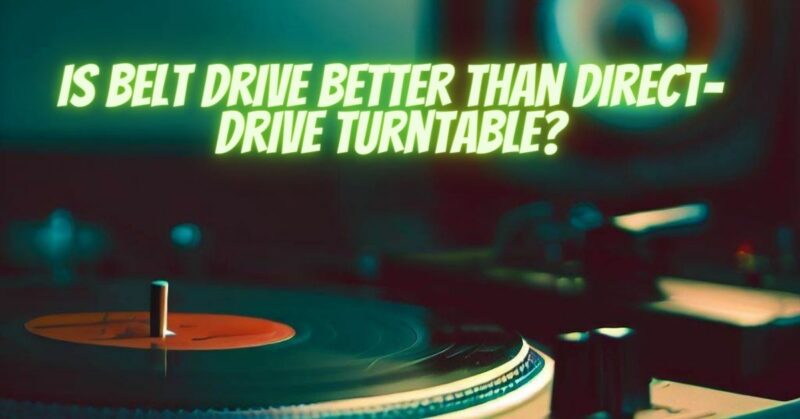The choice between a belt-drive and a direct-drive turntable design is a classic conundrum that has captivated audiophiles and music enthusiasts for decades. Both designs have their merits and considerations, sparking a debate about which is superior. This article delves into the nuances of belt-drive and direct-drive turntables, examining their respective strengths, weaknesses, and how they influence the vinyl listening experience.
Belt-Drive Turntables:
Design: In a belt-drive turntable, the motor is positioned away from the platter and connected to it via a drive belt. The motor’s rotational force is transferred to the platter through the belt, which acts as a cushion, reducing motor noise and vibration transmission.
Advantages:
- Reduced Motor Noise: Belt-drive turntables are known for producing less motor noise, resulting in quieter background noise during playback. This can enhance the clarity and detail of the audio.
- Isolation: The belt acts as a mechanical buffer, isolating the platter from motor vibrations. This can contribute to improved sound quality by minimizing interference.
- Analog Aesthetic: Many audiophiles appreciate the analog and traditional feel of belt-drive turntables. The slower startup time can add to the anticipation and ritual of playing vinyl records.
Considerations:
- Speed Accuracy: Belt-drive turntables can experience slight speed fluctuations over time due to the elasticity of the belt. This may require occasional manual adjustments to maintain accurate playback speed.
- Maintenance: Belts can degrade over time and may need replacement, especially in older turntables. This maintenance task is relatively simple but requires periodic attention.
Direct-Drive Turntables:
Design: In a direct-drive turntable, the motor is directly connected to the platter’s spindle, eliminating the need for a belt. This design provides direct and consistent power transfer.
Advantages:
- Stable Speed: Direct-drive turntables offer stable and consistent rotational speed, making them well-suited for DJing, sampling, and applications where precise speed control is essential.
- Quick Startup: Direct-drive turntables typically have faster startup times, allowing for immediate playback without the warm-up period required by some belt-drive models.
- Reverse Playback: Many direct-drive turntables offer reverse playback, which can be advantageous for certain DJ techniques and creative applications.
Considerations:
- Motor Noise: Direct-drive turntables can transmit more motor noise and vibrations to the platter, potentially affecting the sound quality, especially in high-end audio setups.
- Interference: The absence of a belt can lead to more direct transmission of vibrations from the motor to the platter, potentially causing interference with playback.
Choosing the Right Turntable Design:
The superiority of belt-drive or direct-drive turntables ultimately depends on your priorities and use case:
- Belt-Drive: If you prioritize audio purity, reduced motor noise, and a vintage analog experience, a belt-drive turntable might be your preference.
- Direct-Drive: If you need precise speed control, quick startup, and the flexibility for DJing or creative applications, a direct-drive turntable could be your ideal choice.
The belt-drive vs. direct-drive debate boils down to personal preference, use case, and the sonic attributes you value most. Both designs have their merits and cater to different listening experiences. Whether you’re drawn to the nostalgia of belt-drive or the technical advantages of direct-drive, the magic of vinyl playback is preserved in the rich and captivating sound that both technologies deliver.

